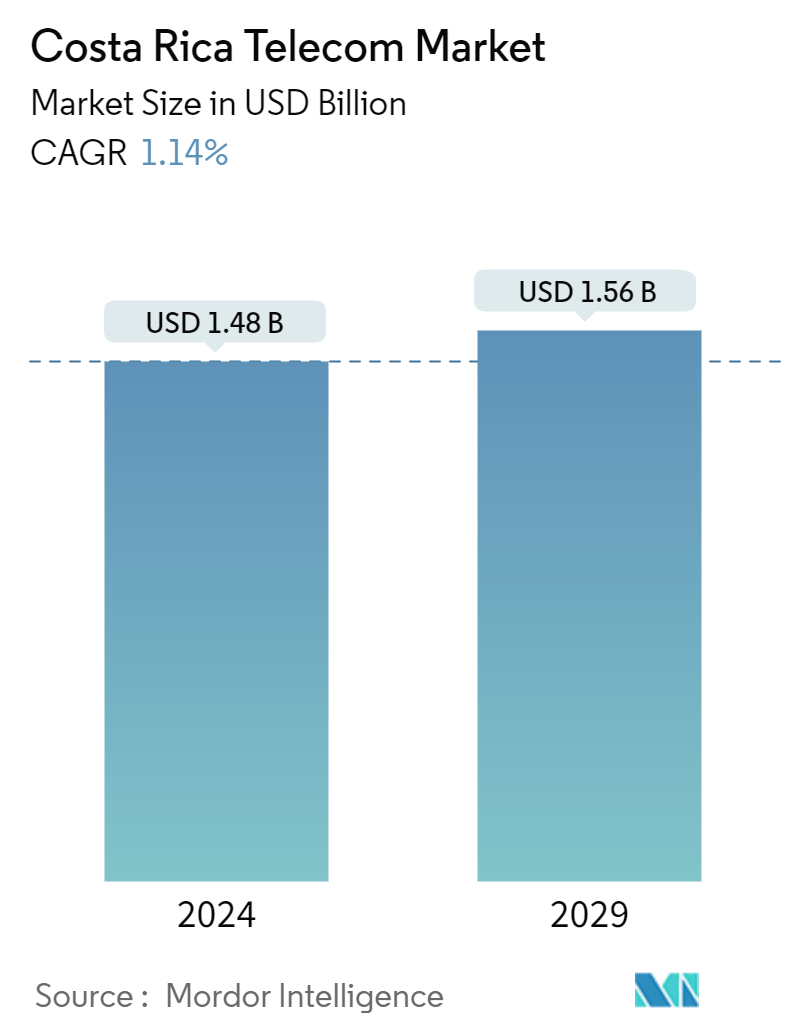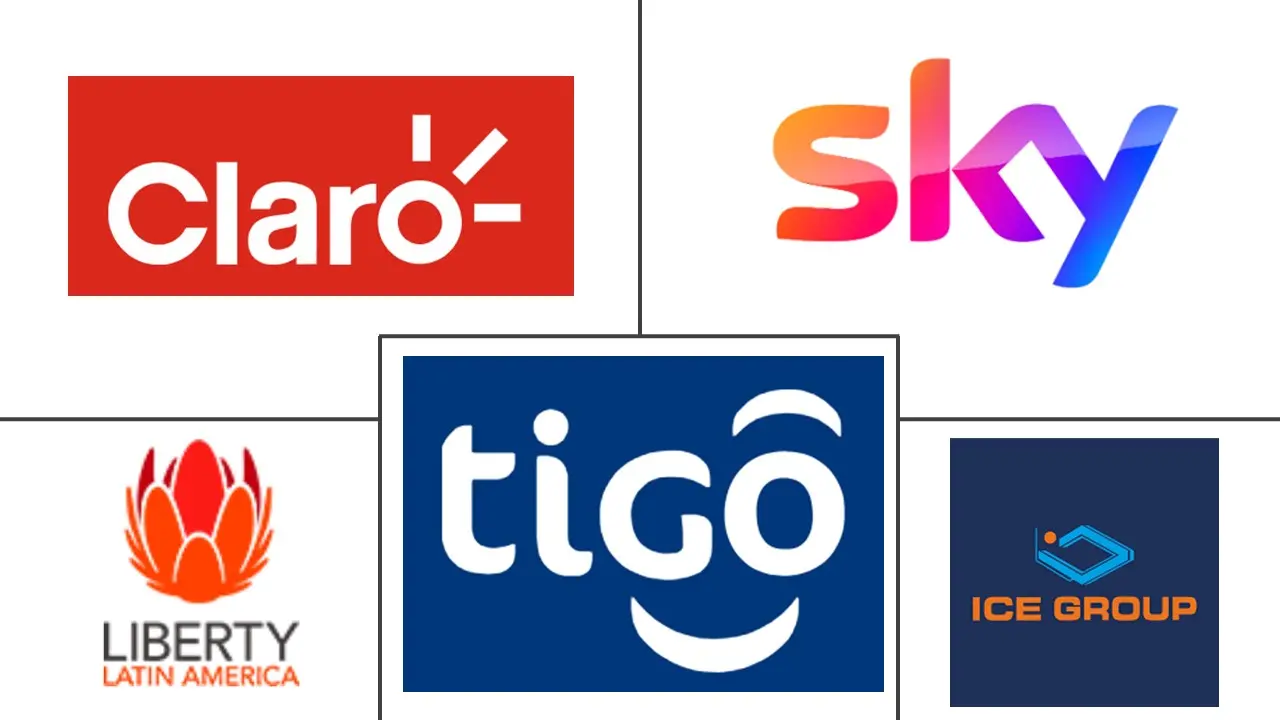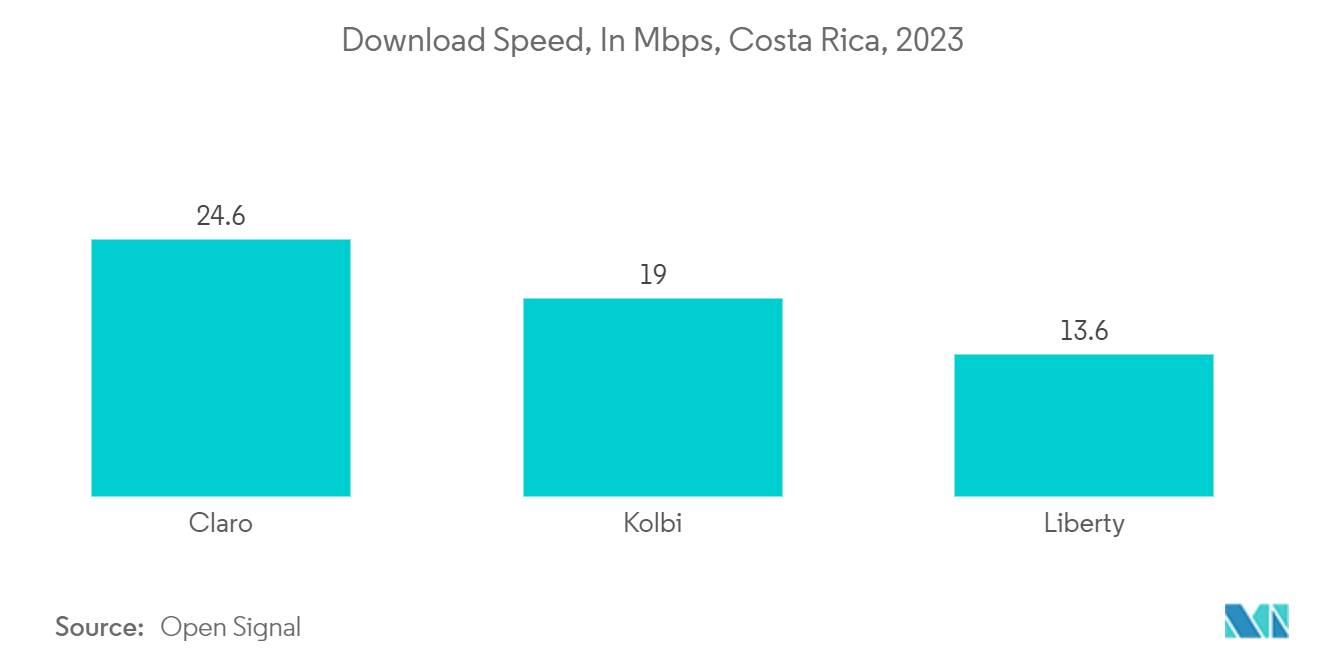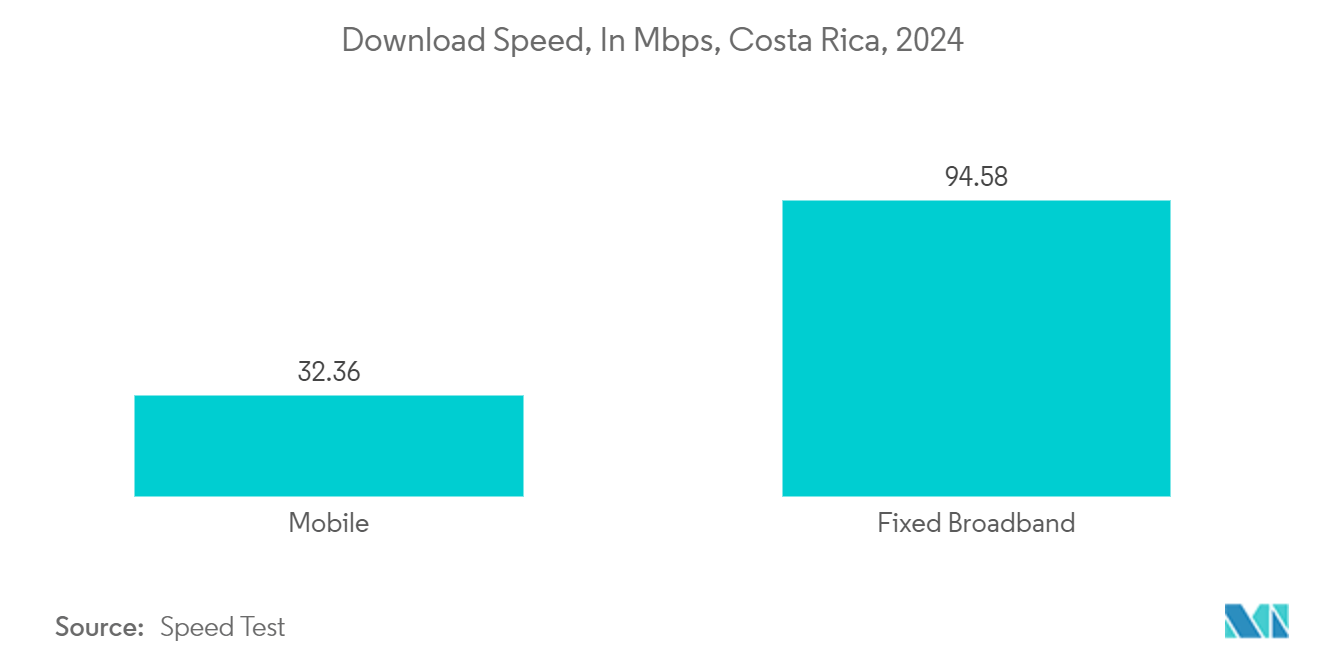Costa Rica Telecom Market Size

| Study Period | 2019 - 2029 |
| Base Year For Estimation | 2023 |
| Market Size (2024) | USD 1.48 Billion |
| Market Size (2029) | USD 1.56 Billion |
| CAGR (2024 - 2029) | 1.14 % |
| Market Concentration | Medium |
Major Players
*Disclaimer: Major Players sorted in no particular order |
Costa Rica Telecom Market Analysis
The Costa Rica Telecom Market size is estimated at USD 1.48 billion in 2024, and is expected to reach USD 1.56 billion by 2029, growing at a CAGR of 1.14% during the forecast period (2024-2029).
- There is a growing demand for high-speed internet, creating a significant demand for expanding 4G LTE and introducing a 5G network. This expansion is planned to cater to both urban and rural areas. The country has a huge national telecommunications network. The surge in telecom subscribers has driven an expansion of networks, requiring substantial investments in telecom infrastructure to cover the growing service area.
- In the first quarter of 2024, Costa Rica's state-owned enterprise, Grupo ICE, channeled a minimum of USD 5.2 million (equivalent to CRC 2.7 billion) into technology and telecommunications. This investment will enhance its network, bolster international connectivity, expand 4G coverage, and advance fiber optics and 5G deployment.
- Government reforms have significantly reshaped Costa Rica's telecommunications landscape. With a vision to position Costa Rica as a prominent global telecommunications hub, the government has taken proactive measures. Notably, the country's telecom segment strongly emphasizes its mobile market, evident in the substantial local capital investments directed toward infrastructure expansion by operators. In 2024, the US government declared that it planned to support Costa Rica in effectively regulating and implementing trusted 5G networks.
- Businesses and government entities increasingly adopt digital solutions, creating a market for cloud, cybersecurity, and other IT services. Telecom companies are investing in comprehensive digital solutions.
- The cost of building telecom infrastructure is high in the country. This includes expenses for spectrum licenses, equipment, and network maintenance, which creates a hurdle for small companies to enter the telecom business. Expanding business in rural areas is also a challenge for the market players since it is not cost-effective to plan expansion in areas with low populations and challenging terrain, which limits the potential customer base.
Costa Rica Telecom Market Trends
Rising Demand for 4G and 5G Services
- There is a growing reliance on smartphones for internet access, social media, streaming, and online communication. The increasing consumer expectations for high-speed, uninterrupted internet access for better user experience in streaming, gaming, and other data-intensive activities encourage the government to invest in infrastructure development.
- In January 2023, IDB Invest and Liberty Costa Rica unveiled an international issuance of a sustainability-linked bond (SLB) worth USD 450 million. This initiative aims to bolster digital access and enhance broadband quality in Costa Rica. The funds raised will be used for various purposes, including improving fiber-to-the-home investments, enhancing the HFC network's capabilities and speeds, funding capital expenditures for 4G/5G infrastructure, refinancing existing financial obligations, and supporting general corporate needs.
- Many market players invest in developing 5G infrastructure to support infrastructure growth. In November 2023, Costa Rica's Institute of Electricity (ICE) issued a call for 5G providers. The company aimed to enhance its 4G LTE and 5G services in the upcoming year. The agency anticipated the selection and contract award process to span around four months, with operations slated to commence in February 2024. The major objective was to invest in goods and services that facilitate the implementation of a 5G network and the development and evolution of LTE networks, with their radio frequency elements, 5G mobile core, routers for interconnection, and adaptations of mobile infrastructure.
- Businesses leverage high-speed connectivity for innovation, improving efficiency, and competitive advantage. Improved 4G and 5G connectivity in urban and rural areas can bridge the digital divide and ensure broader access to digital services. As Open Signal, Claro Costa Rica contributed 24.6 Mbps download speed, followed by Kolbi with 19 Mbps download speed in 2023.
- The smart home devices market is witnessing robust growth, propelled by the IoT device surge. This surge has empowered consumers to remotely monitor and manage their homes for enhanced convenience and energy efficiency. Moreover, the market's expansion is fueled by a growing base of internet users, the pervasive adoption of smart devices, and a rising consumer inclination towards video doorbells, voice tech, and security systems. The market's trajectory has been notably influenced by the advent of advanced image sensors and noise reduction capabilities, driving 5G connectivity for better speeds.

Data Services Hold the Largest Market Share
- Due to the growing demand for internet connectivity, data services contribute significantly to the Costa Rican telecom market. Consumers are increasingly streaming services online, and hybrid work setup is also gaining traction, boosting data consumption. Consumers are opting for data plans over traditional voice services and accessing marketplaces by using data services. According to Speedtest, there is growth in download speed, contributing to 32.36 Mbps speed in mobile in 2024.
- Costa Rica is investing in extending fiber optic infrastructure for faster and more reliable internet connectivity. The country unveiled its telecommunications development plan, outlining public policy goals set for 2024. The plan aims to propel the nation toward digital transformation by emphasizing efficient radio-electric spectrum management and enhancing fixed and mobile telecommunications network accessibility. Notably, two key initiatives have been introduced. The first is 'Connected Communities,' which focuses on extending telecommunications services to various Costa Rican districts, and the second is 'Connected Public Spaces,' aligning closely with the vision of a robust fiber optic network.
- Businesses in the country require robust data services to manage their operations. Market vendors can invest in tailored data service solutions, which include cloud computing, cybersecurity, and enterprise software.
- There is also rising adoption of smart home devices and IoT applications. It increases data consumption and requires a stable internet connection. Thus, government initiatives should invest in building network infrastructure to support modern technological developments.
- Cybersecurity strategy helps in maintaining the integrity of telecom infrastructure. For instance, in August 2023, the United States and Costa Rica unveiled a joint security initiative to bolster Costa Rica's cyber defenses against malicious threats. As part of this collaboration, Costa Rica's Ministry of Public Security is set to establish a Cyber-Security Operations Center by 2026. The initiative encompasses cutting-edge equipment, tailored training, and logistical support, with the United States committing to fund the endeavor through a Foreign Military Financing (FMF) grant.

Costa Rica Telecom Industry Overview
The Costa Rican telecom market is witnessing increasing competitive rivalry as more companies enter, leading to the gradual consolidation of the market. The major market players are involved in various strategies to expand their market share, including mergers and acquisitions. Some of the major players include ICE Group (Kolbi), Liberty Communications of Costa Rica LLC, Claro Costa Rica, Sky Costa Rica, and Tigo Costa Rica.
April 2024: Claro Costa Rica initiated a trial run of its 5G services, with speeds of up to 1.7 Gbps and significantly reduced latency. The 5G coverage spans key locations, including Bijagua de Upala, the Limón baseball stadium, Mall Internacional, Instituto Tecnológico, City Mall, and the San José municipality.
January 2024: Liberty Latin America (LLA) initiated trials of its 5G network in Costa Rica, marking a crucial step toward its planned commercial launch later this year. The company has planned 5G services testing in two key locations: the Universidad Latina de Costa Rica and the Ultrapark Dos commercial campus. At the university, LLA is prioritizing integrating 5G technology in educational and scientific settings, while at Ultrapark Dos, they are testing its applications in areas like energy monitoring, security, and inventory management.
Costa Rica Telecom Market Leaders
-
Group ICE (Kolbi)
-
Liberty Communications of Costa Rica LLC
-
Claro Costa Rica
-
Sky Costa Rica
-
Tigo Costa Rica
*Disclaimer: Major Players sorted in no particular order
.webp)
Costa Rica Telecom Market News
- May 2024: Costa Rica's state-owned operator ICE, under its Kolbi brand, announced plans to phase out its 2G network, commencing in July 2024. The goal is to complete this transition by December 31, 2024, necessitating all customers to possess 3G or 4G-capable devices.
- December 2023: FONATEL, Claro and Ericsson collaborated to extend universal telephony and internet access to Tortuguero and its surrounding rural communities in Limón, Costa Rica. This initiative involved deploying Fixed Wireless Access (FWA) technology, started by FONATEL, Claro, and technology giant Ericsson, ensuring these rural areas access high-speed internet connectivity.
Costa Rica Telecom Market Report - Table of Contents
1. INTRODUCTION
1.1 Study Assumptions and Market Definitions
1.2 Scope of the Study
2. RESEARCH METHODOLOGY
3. EXECUTIVE SUMMARY
4. MARKET INSIGHTS
4.1 Market Overview
4.2 Industry Ecosystem Analysis
4.3 Industry Attractiveness- Porter's Five Force Analysis
4.3.1 Bargaining Power of Buyers/Consumers
4.3.2 Bargaining Power of Suppliers
4.3.3 Threat of New Entrants
4.3.4 Threat of Substitute Products
4.3.5 Intensity of Competitive Rivalry
4.4 Assessment of the Macro Economic Factors on the Market
4.5 Regulatory Landscape in Costa Rica
5. MARKET DYNAMICS
5.1 Market Drivers
5.1.1 Rising Demand for 4G and 5G Services
5.1.2 Government Initiatives Toward Infrastructure Development
5.2 Market Restraints
5.2.1 High Cost of Infrastructure Development
5.3 Analysis of the Market based on Connectivity (Coverage to include In-depth Trend Analysis)
5.3.1 Fixed Network
5.3.1.1 Broadband (Cable Modem, Wireline-fiber, Wireline DSL, Fixed Wi-Fi ), Trends regarding ADSL/VDSL, FTTP/B, Cable Modem, FWA, and 5G FWA )
5.3.1.2 Narrowband
5.3.1.3 Mobile Network
5.3.2 Mobile Network
5.3.2.1 Smartphone and Mobile Penetration
5.3.2.2 Mobile Broadband
5.3.2.3 2G, 3G, 4G, and 5G Connections
5.3.2.4 Smart Home IoT and M2M Connections
5.4 Analysis of Telecom Towers (Coverage to include In-depth Trend Analysis of Various Types of Towers, like, Lattice, Guyed, Monopole, and Stealth Towers)
6. MARKET SEGMENTATION
6.1 By Services
6.1.1 Voice Services
6.1.1.1 Wired
6.1.1.2 Wireless
6.1.2 Data and Messaging Services
6.1.3 OTT and PayTV Services
7. COMPETITIVE LANDSCAPE
7.1 Company Profiles
7.1.1 ICE Group (Kolbi)
7.1.2 Liberty Communications of Costa Rica LLC
7.1.3 Claro Costa Rica
7.1.4 Sky Costa Rica
7.1.5 Tigo Costa Rica
7.1.6 Telecable
7.1.7 Cabletica
7.1.8 Movistar
7.1.9 RACSA
- *List Not Exhaustive
8. INVESTMENTS ANALYSIS
9. FUTURE OUTLOOK OF THE MARKET
Costa Rica Telecom Industry Segmentation
Telecom or telecommunication is the long-range transmission of information by electromagnetic means. The Costa Rican telecom market includes in-depth trend analysis based on connectivity like fixed networks, mobile networks, and telecom towers.
The Costa Rican telecom market is segmented by services [voice services (wired, wireless), data and messaging services, and OTT and pay TV services]. Several factors, including an increasing demand for 5G, will likely drive the adoption of telecom services. The market size and forecasts are in value (USD) for all the above segments.
| By Services | ||||
| ||||
| Data and Messaging Services | ||||
| OTT and PayTV Services |
Costa Rica Telecom Market Research FAQs
How big is the Costa Rica Telecom Market?
The Costa Rica Telecom Market size is expected to reach USD 1.48 billion in 2024 and grow at a CAGR of 1.14% to reach USD 1.56 billion by 2029.
What is the current Costa Rica Telecom Market size?
In 2024, the Costa Rica Telecom Market size is expected to reach USD 1.48 billion.
Who are the key players in Costa Rica Telecom Market?
Group ICE (Kolbi), Liberty Communications of Costa Rica LLC, Claro Costa Rica, Sky Costa Rica and Tigo Costa Rica are the major companies operating in the Costa Rica Telecom Market.
What years does this Costa Rica Telecom Market cover, and what was the market size in 2023?
In 2023, the Costa Rica Telecom Market size was estimated at USD 1.46 billion. The report covers the Costa Rica Telecom Market historical market size for years: 2019, 2020, 2021, 2022 and 2023. The report also forecasts the Costa Rica Telecom Market size for years: 2024, 2025, 2026, 2027, 2028 and 2029.
Costa Rica Telecom Industry Report
Statistics for the 2024 Costa Rica Telecom market share, size and revenue growth rate, created by Mordor Intelligence™ Industry Reports. Costa Rica Telecom analysis includes a market forecast outlook for 2024 to 2029 and historical overview. Get a sample of this industry analysis as a free report PDF download.



